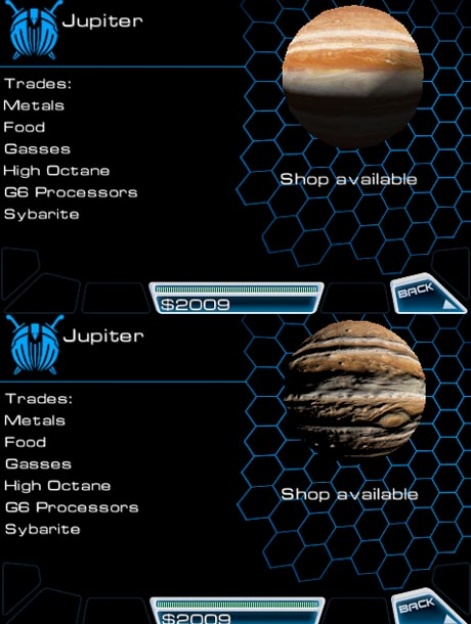Behind the scenes however developers are having to think carefully about how they deal with the different processing capabilities of first generation iPhones and the 50 percent faster iPhone 3GS and new iPod touches.
It's a particular issue as the newer devices support the OpenGL ES 2.0 graphics standard, which isn't backwards compatible with the OpenGL ES 1.1 standard used by older hardware.
Effectively then, some parts of some games are now having to be made twice: with different rendering pipelines for each standard.
One game this impacts and that will be pushing the level of graphics on the various systems is Freeverse's space trader and shooter Warpgate.
We caught up with programmer Mark Levin to find out how the dev team are dealing with such issues.
Pocket Gamer: There's a large performance gap between first generation iPhone/iPod touches and 3GS devices, so how are you ensuring Warpgate looks as good as it can on all of them?
Mark Levin: There are two separate methods of 3D rendering in Warpgate; one written for pre-3GS devices and one written for the 3GS and latest iPods. Each one is being tweaked independently for best performance.
The contents of the game world will remain within the envelop of what we can wring out of the 3G, while 3GS users will see the extra normal mapping effects and also run at a higher and more consistent framerate.
Will there be a separate release for 3GS devices?
Warpgate will ship with support for both 3GS-specific features and older devices in the same binary. The game will detect the capabilities of the device it's running on and enable and disable features as appropriate.
You're using OpenGL 2.0 in the 3GS version of the game, which isn't backwards compatible with the older OpenGL ES 1.1, so how does this make development much more complex?
From the perspective of a single title, yes - supporting 3G devices [OpenGL ES 1.1] while taking advantage of the 3GS [OpenGL 2.0] requires additional time and engine complexity.
However, the work we've done to support multiple render paths in Warpgate is now part of Freeverse's library of iPhone software technology, and future titles will be able to take advantage of it from the get-go.

Most iPhone games at this point in the platform's life are not so strongly tied to advanced graphical effects as titles on full game consoles or PCs are, and removing a normal map here or a dynamic light source there will still leave a 3G user with a good experience that represents all the important parts of what a game offers.
The tipping point at which 3G compatibility starts to become an obstacle to evolving iPhone game design will likely come when ES 2.0 devices start to outnumber 1.1 devices, which they won't do until well into 2010.
Why do you think techniques such as normal maps are important in a game such as Warpgate?
Warpgate isn't a frenetic and intense action-oriented game; it's more relaxed and gives the player time to think and look around. We allow so many opportunities to stop and smell the roses that we have to make sure those roses smell as nice as possible. ES 2.0 on the 3GS gives us one more way to do that.
In addition, we felt the need to develop the aforementioned hardware-agnostic renderer now that the 3GS was on the scene, and Warpgate was an ideal test case as a stable, mostly finished, graphically high-end game which would benefit from the advantages it provided.
Normal maps are standard in console games but aren't they overkill for iPhone both in terms of the art process to generate the high resolution models and the memory requirement in terms of the extra textures?
The memory cost is offset by the fact that Apple already included more memory in the devices capable of ES 2.0, in anticipation of this issue. The 3GS is also so much faster than the 3G that load and preprocess times are still shorter than on the 3G despite the additional work being performed.
The jump from 3G to 3GS is not like installing a new graphics card in a computer and leaving everything else untouched; Apple upgraded every aspect of the device simultaneously so that they complement each other and enable new techniques with no strings attached.

The addition of normal maps to 3D model production may be a new thing for cellphone games, but many 3D artists already have experience in other aspects of the game industry where normal maps have been in wide use for years, and the process is efficient and well-understood.
We were already using extra fine surface detail baked into texture maps for our games solely targeting the 3G anyway; exporting that work as a normal map ready to drop into an ES 2.0 game is merely a menu command in most 3D modeling programs.
Do you think it's a concern that iPhone developers may end up in a technological arms race, which will end up costing more in additional development than can be made back in terms of the additional price you can charge for better looking games?
That's less of a technical question. The App Store is a more dynamic and energetic market than a tightly controlled console, and Apple has a habit of making sudden and radical changes to the playing field.
There's also a large population of hobbyist and amateur developers, whose influence on the store is unprecedented as far as unified software distribution systems go and who are more or less competing via ideas and game design with the major studios whose strengths are polish, large-scale engineering, and volume and quality of content.
I don't think the phone will ever hit the rapidly spiraling costs of current major console games, but it will certainly be an interesting field as more and more programmers start to play with ES 2.0 and come up with new ideas.
Thanks to Mark for his time.
Warpgate is due to be released in Q4 2009.






















